
Ephemera: Pins and Buttons
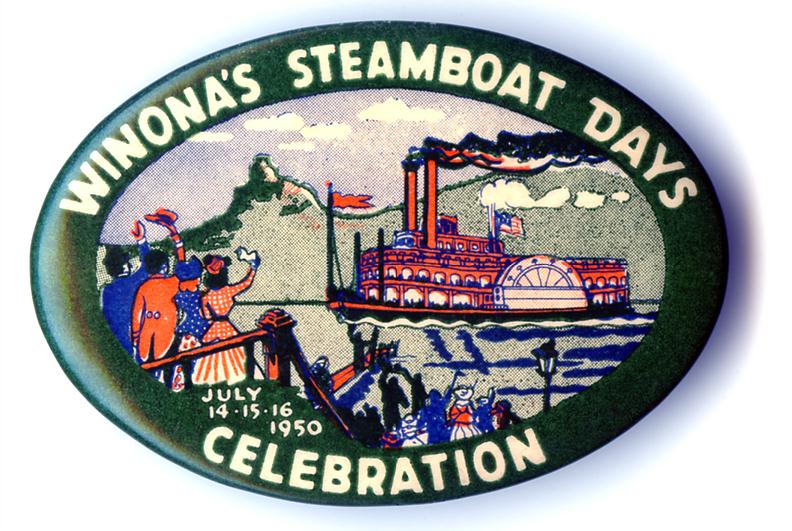
My favorite pin back which in style looks earlier than 1950 1.60 X 2.30 inches on folded edge on the back it says MIDWEST BADGE & NOVELTY CO. INC. - MINNEAPOLIS.
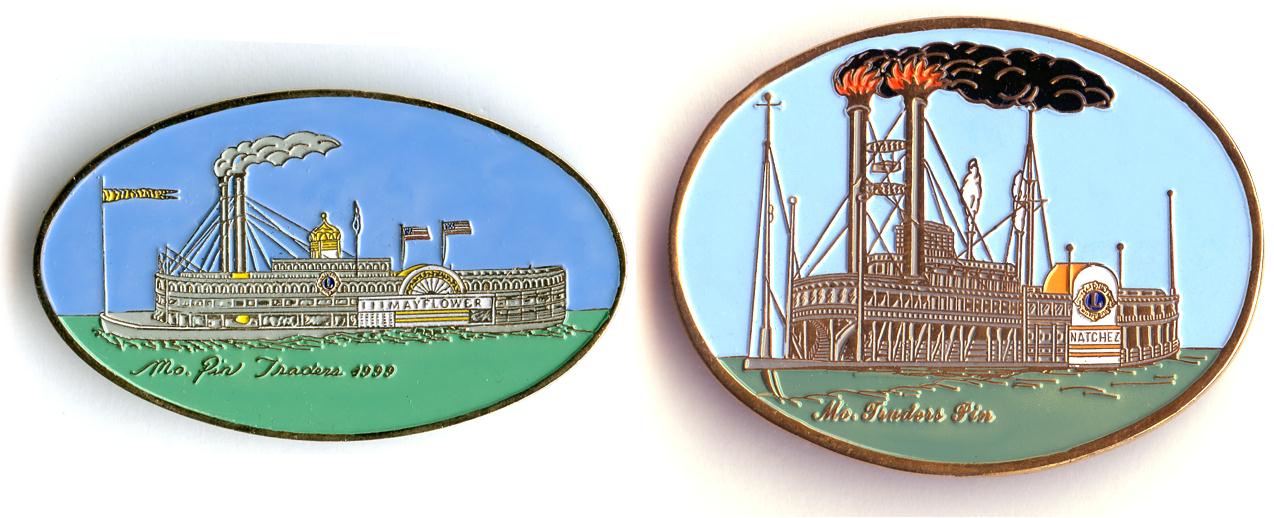
A couple of good sized Lions Club pins from Missouri Pin Traders: 1.80" X 3.00" MAYFLOWER (1999) 2.25 X 3.00 NATCHEZ
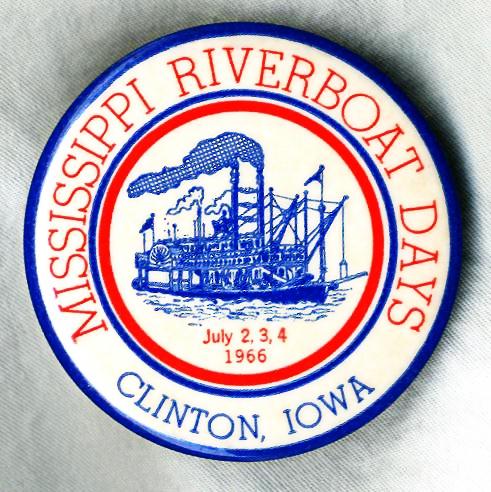
Self evident pin back button from 1966.
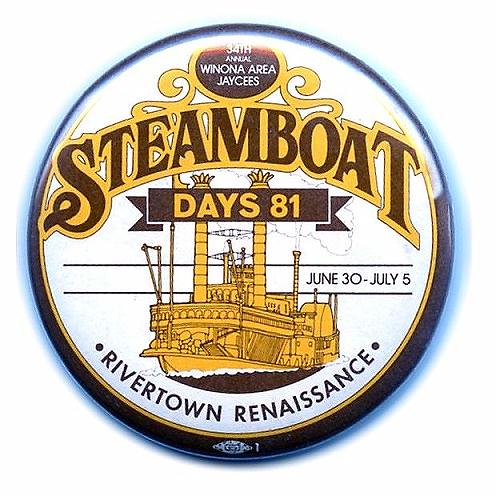
2.20 inch pin back button made for Winona, MINN's 34th annual Steamboat Days, June/July 1981
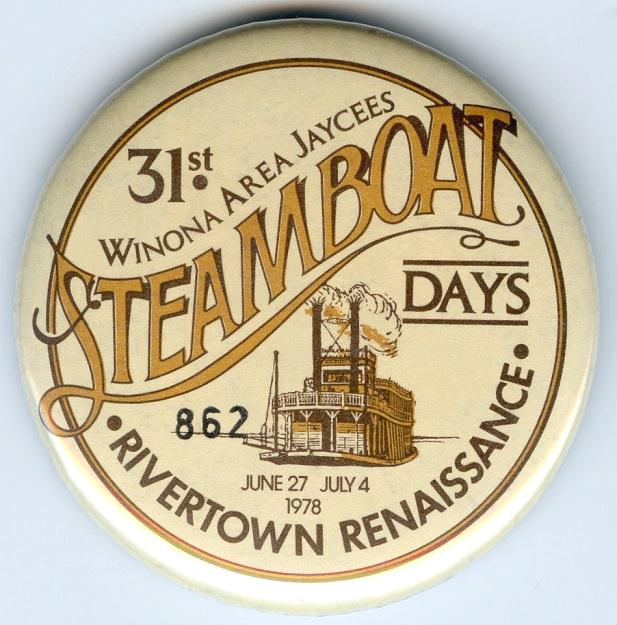
Winona, Minnesota June 27 - July 4, 1978
31st Annual STEAMBOAT DAYS - Badge No. 862
Winona Area Jaycees RIVERTOWN RENAISSANCE
2 1/4 inch pin back button
Once again it appears that the artist based the steamboat on the little White River (Arkansas) steamboat MARY WOODS No. 2 that was on display at Jacksonport, Arkansas until she sank and nobody wanted to pay the cost of restoring her so she was scrapped in 2011. The artist who painted the MARK TWAIN FOREVER postage stamp also used the MARY WOODS No. 2 as a model for his steamboat.
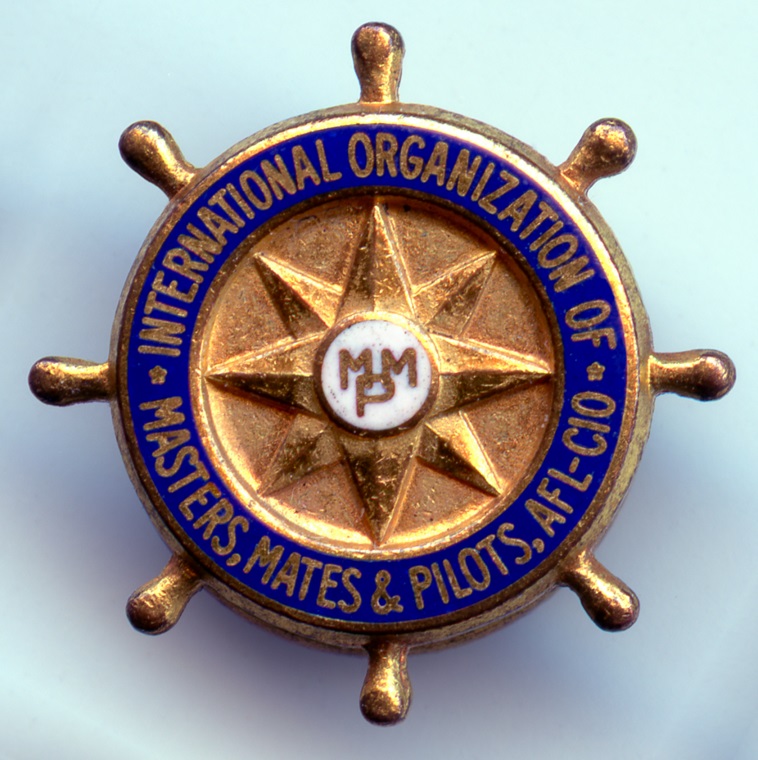
Member's lapel pin: International Organization of Masters, Mates & Pilots Lapel pin .65 inches in diameter for members of t he International Organization of Masters, Mates & Pilots or MM&P is a United States labor union representing licensed mariners. It is the marine division of the International Longshoremen's Association.
wikipedia.org
MM&P represents licensed deck officers on U.S.-flag commercial vessels sailing offshore, on the inland waterways and on civilian-crewed ships in the government fleet; state-licensed marine pilots; marine engineers; mariners who work on tug, ferry and harbor tour vessels in New York Harbor and throughout the Northeast; licensed and unlicensed mariners who work on dredges; and maritime industry shore-side clerical and service workers. In addition, it operates two training facilities: the Maritime Institute of Technology & Graduate Studies near Baltimore, Maryland; and the Pacific Northwest Maritime Institute, in Seattle, Washington. It operates hiring halls in port cities in the continental United States, Hawaii and Puerto Rico. MM&P's historical roots lie in the frustration felt by steamship pilots who were criminalized for marine accidents but had no voice in policy. They organized in New York in 1887, forming the first local of the American Brotherhood of Steamship Pilots. As more locals were founded, shipmasters expressed interest in joining. As a result, in 1891, the fledgling union changed its name to the American Association of Masters and Pilots of Steam Vessels. In 1900, it expanded once again to include all deck officers, and changed its name to the American Association of Masters, Mates, and Pilots of Steam Vessels. MM&P was active in the 1934 West Coast waterfront strike, joining in along with the Marine Engineers' Beneficial Association (MEBA) on 19 May 1934. Together, in 1937 the two unions became part of the Maritime Federation of the Pacific (MFP). The alliance, however, was short-lived. In July 1938, MM&P withdrew from the MFP, along with the Sailors' Union of the Pacific and the Marine Firemen, Oilers, Watertenders, and Wipers of the Pacific Coast Union. In 1954, the union added Canadian locals, and changed its name to the International Organization of Masters, Mates & Pilots. In 1971, by becoming an affiliate of the International Longshoremen's Association, MM&P was able to distance itself from the fight between the American Federation of Labor's (AFL) Seafarers International Union on one side and the Congress of Industrial Organizations's (CIO) National Maritime Union (NMU) on the other. The link has sometimes been tenuous: some 17 years later, when NMU joined MEBA, MM&P very nearly followed suit.
Archives
International Organization of Masters, Mates, and Pilots, Local 6 (Seattle, Wash.) Records, 1964-1966 At the Labor Archives of Washington State, University of Washington Libraries Special Collections Guide to the Vernon R. Stedman Papers. 1933-1972. 1.21 cubic feet (2 boxes).
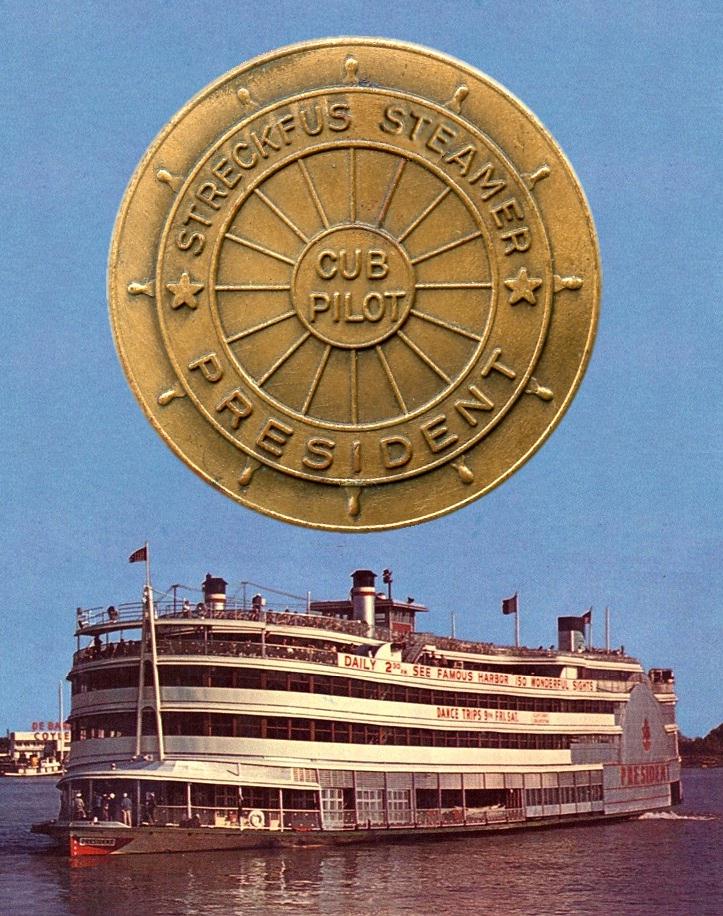
Streckfus Steamers issued this pin 1.20 inches in diameter that was probably intended to be given to honored guests who visited the pilot house of the PRESIDENT and were privileged to "steer" for a while under close supervision.
PRESIDENT
Way's Packet Directory Number 4578
Sidewheel Excursion boat
Built in1924 at Midland, Pennsylvania (hull)
Formerly the CINCINNATI
Owned by Streckfus Steamers, Captain Verne Streckfus (master) [1933] New Orleans Steamboat Company [1981]
After being sold to Streckfus Steamers, she received an entire new superstructure and came out on July 4, 1934 as the best excursion boat on the rivers. She could carry 3,100 passengers. In 1944, after she became the full-time excursion boat in New Orleans, her guards were glass-enclosed. In 1978 she was converted to diesel.
After serving as a casino boat at Davenport during the 1990's she was retired and replaced. The party who bought the PRESIDENT planned to turn her into a hotel so she was dismantled and the pieces taken far from the river to a location near St. Elmo, Illinois where she sat for two years unassembled until the pieces were moved to Altamont, Illinois where the parts began to disintegrate. Finally the parts were sold as scrap. Bill Wundram in the June 29, 2015 edition of the Quad City Times wrote an informative biography of the PRESIDENT that told her story on up to her inglorious finale. Here is the link to the online version of Bill's article: qctimes.com
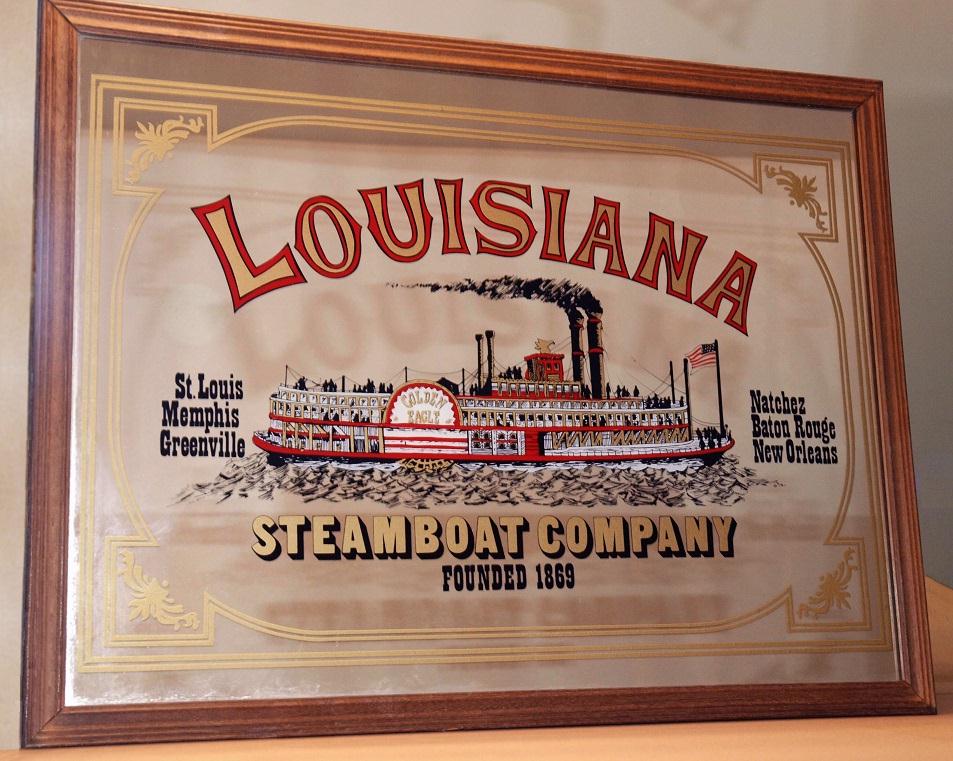
Decorative mirror for a fictional "Louisiana Steamboat Company"
18 x 24 framed mirror circa 1970-80 for the fictional "Louisiana Steamboat Company - Founded 1869.
Probably intended as décor for bars or lounges "Down South." The artist and/or designer of the mirror may have taken a shine to the name of Captain Buck Leyhe's beloved sternwheel GOLDEN EAGLE (1918 - 1947) and decided to assign the name to the sidewheeler in the graphic portion of the mirror.
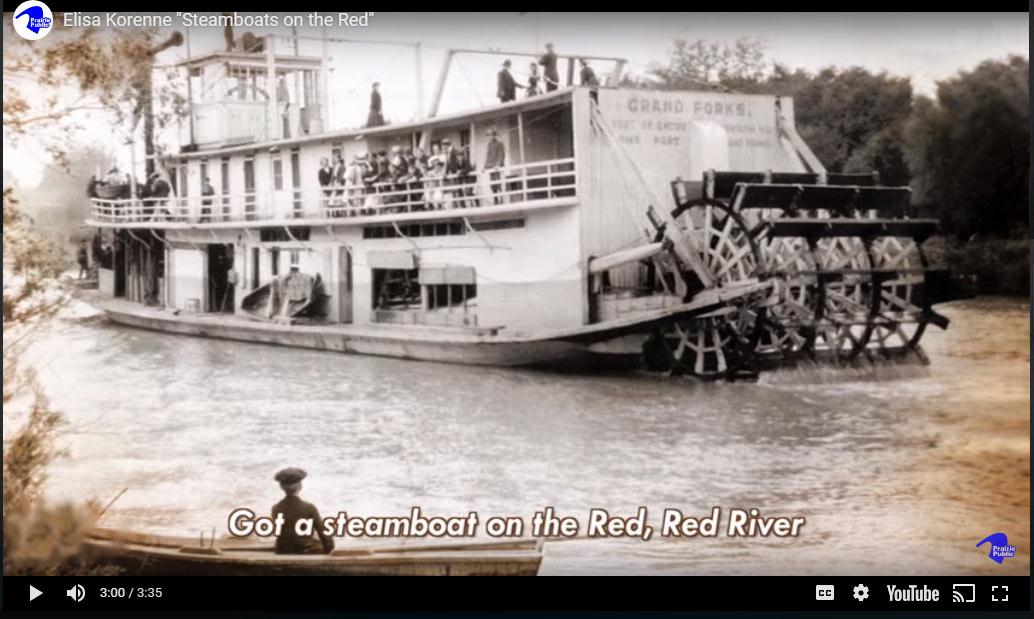
Elisa Korenne "Steamboats on the Red"
Youtube
Prairie Public
Published on Jul 1, 2014
Looking at the shallow twists and turns of the Red River, it's hard to imagine that steam-powered paddlewheel boats were once the most important transportation link between St. Paul and Winnipeg.
This original song by Minnesota musician Elsia Korenne tells the tale of willpower and cut-throat competition that brought steamboats to the Red and made them work. Production funding provided by the Minnesota Arts & Cultural Heritage Fund and by the members of Prairie Public About the Minnesota Arts and Cultural Heritage Fund.
In 2008, Minnesota voters passed a landmark piece of legislation—the Minnesota Clean Water, Land, and Legacy Amendment—which provided funding to public television stations serving audiences in Minnesota. Its mission is to help preserve and document the treasures of culture, history, and heritage that make Minnesota special, and to increase access to the natural and cultural resources we all share.

OH! SUSANNA! Hillary Klug Vocalist, Fiddle Player &Buck Dancer
TALENTED YOUNG HILLARY KLUG SINGING, PLAYING THE VIOLIN AND BUCK DANCING ON THE CUMBERLAND WITH THE GENERAL JACKSON PADDLING AWAY BEHIND HER. HILLARY RIVALS JOHN HARTFORD AS A PERFORMER.
Multitasking!! Fiddle-Dance-Sing "Oh! Susanna" Hillary Klug Old-Time Hillary Klug fiddles, dances, and sings "Oh! Susanna" on the river with a show boat in the background....
Youtube
Middle Tennesse State University graduate uses her feet and fiddle to busk full time on Broadway in Nashville
Tayhlor Stephenson
For USA TODAY NETWORK - Tennessee
Oct. 26, 2017
Saturday rolls around, and 25-year-old Hillary Klug—wearing cowboy boots, which she claims to be her dancing shoes, a gray T-shirt and cuffed blue jean shorts—shuffles her feet to the beat of her fiddle.
"Now, that's Nashville," says a passerby, in awe of Klug's multitalented trade.
The Tennessee-based musician calls the corner of Fourth and Broadway her work home. In addition to busking full time, she's recording her debut album, "Fiddle Feet," and she's also filming a scene and recording the soundtrack for an independent film set to release next summer.
Her ability to draw enthused crowds with only her feet and fiddle has led to many awards, including the title of National Buck Dancing Champion, which she earned in July 2013 at the Uncle Dave Macon Days
"The combination of the fiddling and dancing is what makes Hillary special," says 53-year-old Jim Wood of Flat Creek, Tenn., Klug's longtime fiddle instructor. "There are good fiddle players and there are good dancers, but I don't know anybody in the United States who dances as well as she plays or plays as well as she dances."
Klug grew up in Fayetteville, Tenn., as the youngest of three children, all of whom were home-schooled by Klug's mother, Nancy. While her mother taught the children and worked as a caregiver to the elderly, Klug's father, Mike, worked as a carpenter.
"Both my parents were kind of self-employed; they took their own financials into their own hands," Klug says. "It just came natural to me to use the talents I had to make money rather than having to go find an employer to give me a steady paycheck."
Lexi Lew, a 23-year-old busking regular, understood what it took to become a street performer, and she encouraged Klug to do it for a living.
"More people travel the streets rather than each individual bar, so more people see your talent on the streets," Lew says. "Also, it's not bad money when you're talented like Hillary."
But it's not all about the money for Klug.
"I love busking," she says. "I'm out there because people love me, and I like contributing to the atmosphere. I would still be doing that even if I weren't making any money."
Klug knew at an early age that her script would include a fiddle on-shoulder. By 13, she pleaded with her mother to take violin lessons.
"My mom made a deal with me," Klug says. "She said, 'You pay for half of the violin, and I'll pay for the other half of it . . . but if you quit taking lessons, you have to pay me back for my half.'
So, I kept taking lessons and never quit."
Klug later ran into Wood at the Flat Creek Dance, a contra dance-focused gathering that meets at the Flat Creek Community Center every other Tuesday.
Not only did Wood help musically, he also lent one of his property's homes for rent while Klug studied at Motlow State Community College in Tullahoma, where she earned a $5,000 scholarship to study music in Brazil for a month.
But fiddling wasn't enough to preoccupy Klug—or her fans, for that matter.
She soon found herself competing in dance competitions—which usually offered a clogging and buck dancing category—while at festivals and other events. Next on Klug's plate: buck dancing.
After graduating from Motlow in 2014, Klug transferred to Middle Tennessee State University and earned a bachelor's degree in English. In May 2015, she married her husband, Michael, whom she also met at the Flat Creek Dance.
With a luscious garden, chickens aplenty, four cats and an Anatolian shepherd named Ataana, Klug lives a full life, but it wouldn't be complete without her beloved arts.
There's just one problem: Legal officials are running these performers off the streets under an ordinance. That has yet to stop Klug from sharing her musicality, though.
Her talents have garnered her titles like the Kentucky State Championship in 2013, and under Nic Gareiss, Klug traveled Ireland for nine days to study dance in April. She's also traveled Europe—Ireland, France, Belgium, Netherlands, Germany and Luxembourg—to broaden her busking.
Klug dreams of nothing more than playing the Grand Ole Opry one day. Until then, street performing—and the ongoing fight to rightfully busk on Nashville's streets—preoccupies her.
"She's done what all serious musicians do, as far as she has learned from many traditional sources and everything, but she's not stopped at that. She's coming up with her own thing based on the traditions," Wood says.
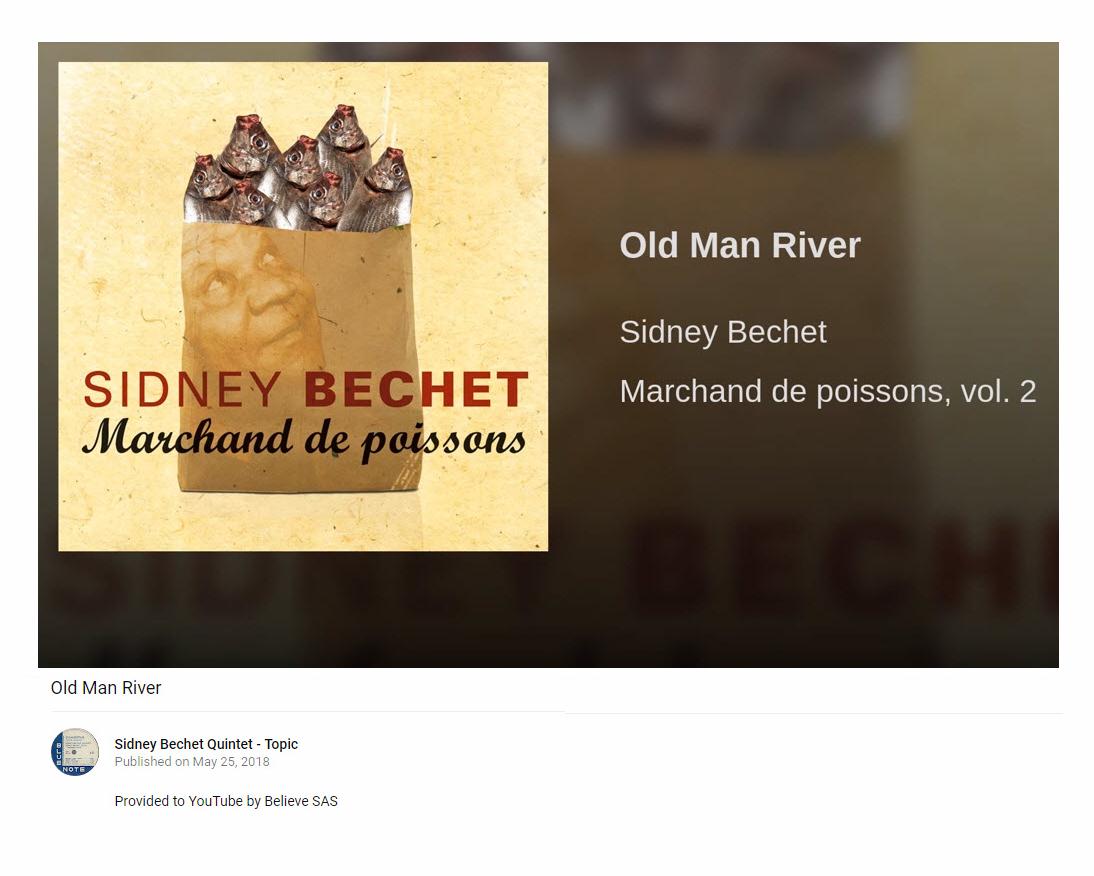
OLD MAN RIVER - New Orleans Jazz version by Sidney Bechet Quintet
For folks who want to hear a pure New Orleans jazz band rendition of Jerome Kern's OLD MAN RIVER, here's the link to one of Sidney Bechet's versions. Bechet's style of playing sax and clarinet transcended what was being done by other musicians and bands that were contemporaries of his.
Sidney had an unmistakable unique sound that you will recognize after you've heard it once and from then on whenever you hear just a few notes played by him you'll say Bechet.
Youtube
Old Man River
Sidney Bechet Quintet - Topic
Published on May 25, 2018
SUBSCRIBE 10
Provided to YouTube by Believe SAS Old Man River - Sidney
Bechet
Sidney Bechet (May 14, 1897 - May 14, 1959) was an American jazz saxophonist, clarinetist, and composer of the swing jazz era and genre. He was one of the first important soloists in jazz, beating trumpeter Louis Armstrong to the recording studio by several months.
Bechet was born in New Orleans in 1897 to a middle-class Creole of color family. His older brother, Leonard Victor Bechet, was a full-time dentist and a part-time trombonist and bandleader. Bechet learned several musical instruments that were kept around the house, mostly by teaching himself; he decided to specialize in the clarinet.
"I started by playing The Sheik on piano, and played the drums while listening to the piano. I meant to play all the rhythm instruments, but got all mixed up and grabbed my soprano saxaphone, then the bass, then the tenor saxophone, and finally finished up with the clarinet."

Yarns by the Yard - By R. V. Garber No. 1 Famous Whistle Creek Steamboats
Yarns by the Yard
By R. V. Garber
No. 1": Famous Whistle Creek Steamboats
NATIONAL WATERWAYS
FEBRUARY 1932
pages 26 & 48
Time has blotted out old landmarks which might lead to the recalling of the one-time famous Whistle Creek and its steamboats, obliterated in 1811 by the New Madrid Earthquake which completely buried creek and boats for all time. Some of the old faithful descendants of rivermen still believe, as did their forefathers, that Whistle Creek and its steamboats is still in existence, now flowing under the ground as placidly as ever on its way to the Mississippi.
But Whistle Creek is only a memory. But what a memory! In 1800 steamboating on Whistle Creek was at its heighth and glory. The famous Tri-State Packet Line, owned by Captain Trio, was operating three steamers: the State of Collapse, State of De Jection, and the State of De Pendence. These boats are deserving of mention
The State of Collapse was built at New Orleans in 1790, out of the lumber from a dismantled whaling ship. She was the largest of the three boats, being 125 feet long and 32 feet wide. Because she was so long she could not be turned around in the Creek at any point, so a pilot house was built at both ends of her with a smoke stack behind each. Thus, when she reached the end of her run the pilots, like a motorman on a one-man street car, simply changed pilot houses and ran the boat backwards.
The State of De Jection was formerly owned by Captain Mellon Cholly of Vicksburg, Miss., who became so depressed after riding on her for one season that he committed suicide by jumping into her sternwheel. The De Jection was said to be the slowest steamboat ever built. It was known to be a fact that if sails were installed on her she would make better time in the calmest weather with her engines stopped, than she would with them going full speed ahead. It was Captain Mellon Cholly himself who gave the poet Samuel Taylor Coleridge the inspiration for his poem, "Dejection: An Ode."
The State of De Pendence was built out of the old State of Coma which exploded in 1795, leaving her master, Captain De Linquent, in a profound condition of insensibility. He set to work to rebuild her, but when he got her finished he had used up all his fortune, so she was sold to the Tri-State Line who named her State of De Pendence because her usefulness after her explosion was always depending upon additional money for new parts. She was, however, unusually fast, which was believed the cause of her explosion. Often times if her engines were allowed to run full speed her wheels would revolve so fast they would suck all the water away from around her hull, and she would be seen scraping along the river bottom going from thirty to thirty-five miles an hour with mud flying in all directions.
The State of De Jection was in the peanut butter trade between Cairo, Ill., on the Mississippi and Poplar Bluff, Mo., on Whistle Creek. Because she was so slow the peanut butter concern moved their factory on the boat, and so peanuts loaded at Cairo were made into peanut butter, put into jars, and were ready for distribution by the time the De Jection reached port. The State of De Pendence was in the apple butter trade between Hamburg, Ill., on the Mississippi, and Poplar Bluff on Whistle Creek, a distance of 860 miles which this boat covered in a day and a half. She was so fast she would often be back at Hamburg before the apple pickers had gathered enough of the fruit to make another trip profitable. The State of Collapse ran in the cotton trade between Memphis, Tenn., on the Mississippi and Poplar Bluff on the Creek.
One night these three boats met in a triple collision at Dead Man's Elbow on Whistle Creek. The damage would have been slight had it not been for the terrific speed at which the De Pendence was traveling. As it happened, the State of Collapse was passing the State of De Jection just as the State of De Pendence whizzed around the Elbow unaware of the presence of her sister boats. She ran between the left bank and the State of De Jection, side-swiping her and pushing her against the port side of the State of Collapse which forced both these boats out of the creek and up on the right bank with peanut butter and cotton flying hither and yon. It was a terrible sight to see the stricken passengers and crew struggling through this sticky conglomeration which held them like flies in molasses. The peanut butter was worse than quicksand, while the cotton suffocated scores. Many believe that this mixture of peanut butter and cotton lead to the making of what is known today as "Karmel Carn."
The accident happened so quickly that the State of De Pendence reached port before she could stop or was aware of what had taken place. And that was the end of the State of Collapse. She was true to her name after that—a mass of wreckage high and dry on the bank where she remained until the earthquake buried her. The State of De Jection, however, was reconditioned, but she turned out to be slower than ever and never reached Cairo again because, on her first trip out her crew died of old age on the way.
The State of De Pendence remained in service and was not destroyed until the day of the New Madrid Earthquake when, in an effort to out-distance the earth tremors, she ran into some low-hanging trees and tore off her upper works while the hull, with the engines on it, ran wild across country for an hour and a quarter until her fuel supply gave out. She then make a perfect landing with her port side against a farm house which a second later was wrecked by the quake and collapsed just as the farmer and his family ran out to seek shelter in the hull.
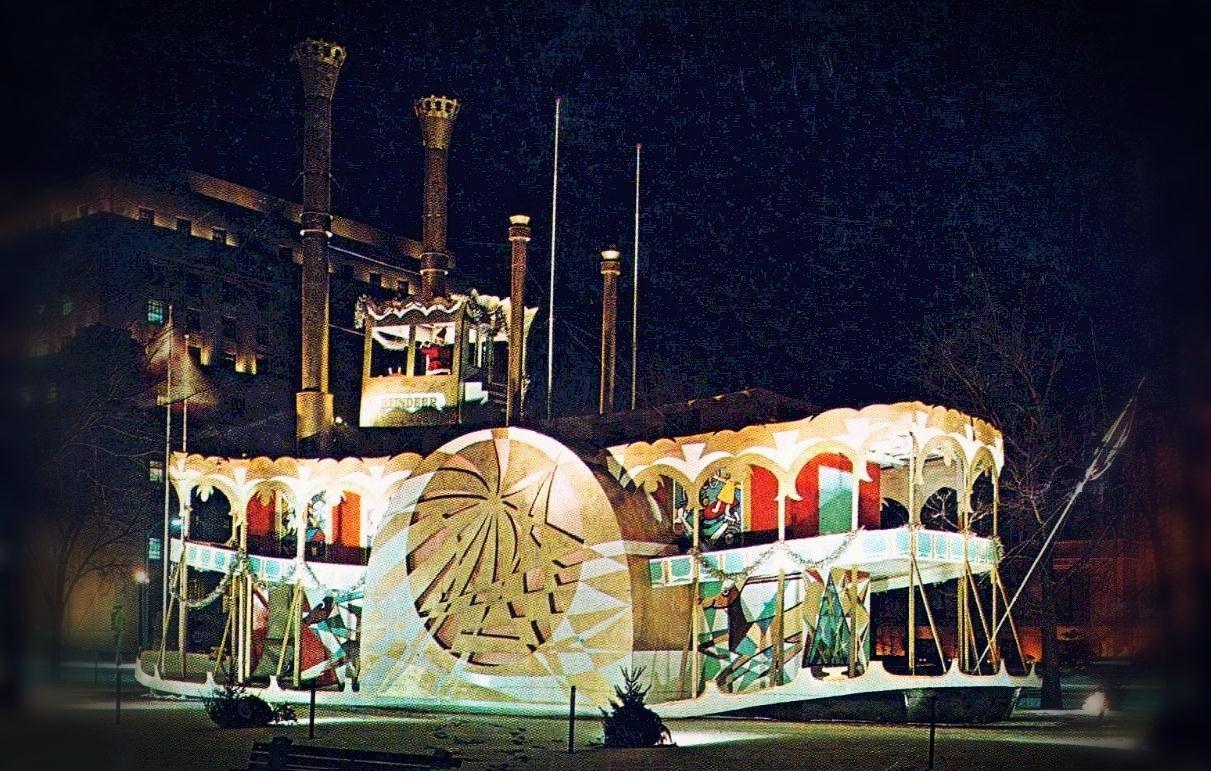
Christmas themed steamboat replica REINDEER
Night time color photo by Jack Zehrt of a charming stylized sidewheel steamboat Christmas themed display taken at St. Louis Memorial Plaza in 1960.
Santa in the pilot house, nice variation on steamboat gingerbread along the boiler deck promenade, leaded glass windows on the bulkheads, sophisticated abstract design on the paddlebox. Would be interesting to new who the artist or artists were who designed this and put it together. It looks like it could have been right at home in the Pasadena Rose Parade. It has a spiritual quality symbolizing your faith in steamboats as floating guardian angels.
Mardigraw Chris'muss!
photojournalismhalloffame.org
JACK J. ZEHRT (1920-2010), noted Midwest photographer, developed a unique, artistic photography style all his own during his 70-year career as a professional North American photographer.
From Route 66 to baseball players to space, St. Louis County photographer Jack Zehrt's wide range of photographs have appeared in ads, magazines, brochures, posters, bank checks, greeting cards and calendars worldwide.
Zehrt's career in photography started after high school in St. Louis, when he worked as a freelancer. A few years later he began working for the St. Louis Globe-Democrat.
In 1943, his first year at the Globe-Democrat, Zehrt won the AP's Picture of the Year award for capturing a glider carrying the St. Louis Mayor and nine others as it crashed to the ground. Zehrt was only 23.
Zehrt left the Globe-Democrat in 1955 to become a stock photographer, meaning he decided the subjects of his pictures and marketed them through a New York agency. Most notable are his photos of space, specifically his series of city skylines with the moon hovering above. He developed a relationship with NASA through his "astrophotography," the photographing of objects in space.
His collection also includes hundreds of photos from Route 66, dating to 1947. He made a 1999 calendar using photos only from the Missouri part of 66. Zehrt made several cameras. His portfolio contains remarkable collections of animals in the St. Louis Zoo, of St. Louis Cardinals and other famous baseball players and of construction of the Gateway Arch.
His sports photos have been in wide demand.
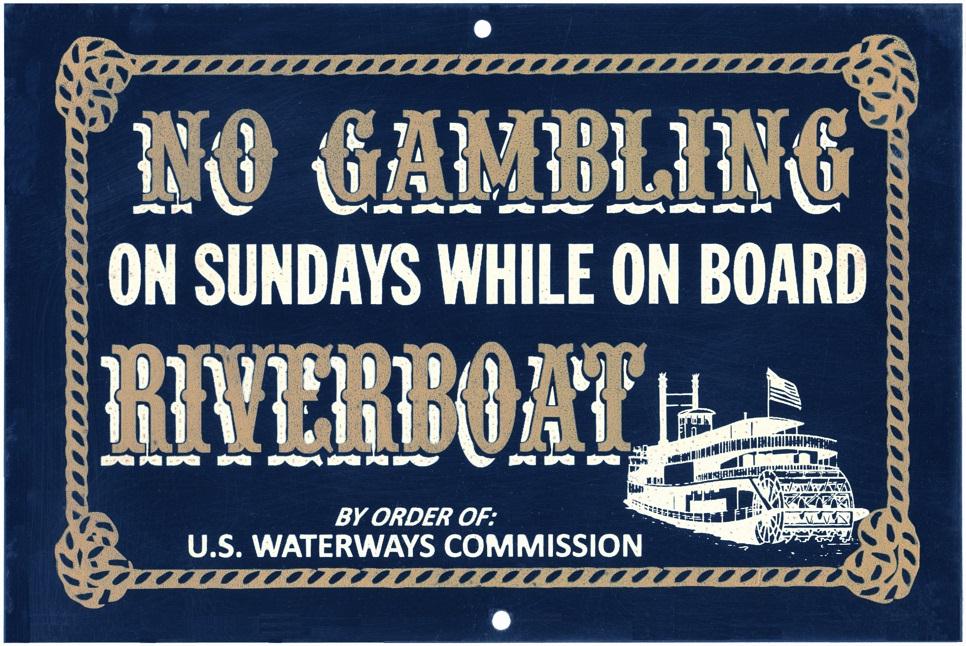
"No Gambling" Aboard on Sundays" sign
8 x 12 inch "Faux" sign silk screened on heavy sheet metal in gold and white on black background which came out a dark navy blue in the attached scan.
"NO GAMBLING ON SUNDAYS WHILE ON BOARD RIVERBOAT
BY ORDER OF: U.S. WATERWAYS COMMISSION"
(COMMISSION was misspelled with only one "S" so I corrected here in Photoshop, makes a better presentation).
Possibly this was sold as souvenir or as home décor for bars and "man caves" Must have been made after 1975 since the steamboat graphic is derived from a photo of the modern NATCHEZ at New Orleans which was launched in '75.

Steamboat "STONEWALL JACKSON" necktie
Necktie (from the 1950's or '60's?) with a repeated image of what I was able to decipher as a steamboat called "STONEWALL JACKSON." The appearance of the fabric (weaved?) has an "embroidered" appearance. I scanned this over the back of a shirt whose coral color closely matches the color of the pennant, flags, name on the paddle box and the accent stripe that runs above and below the procession of steamers.
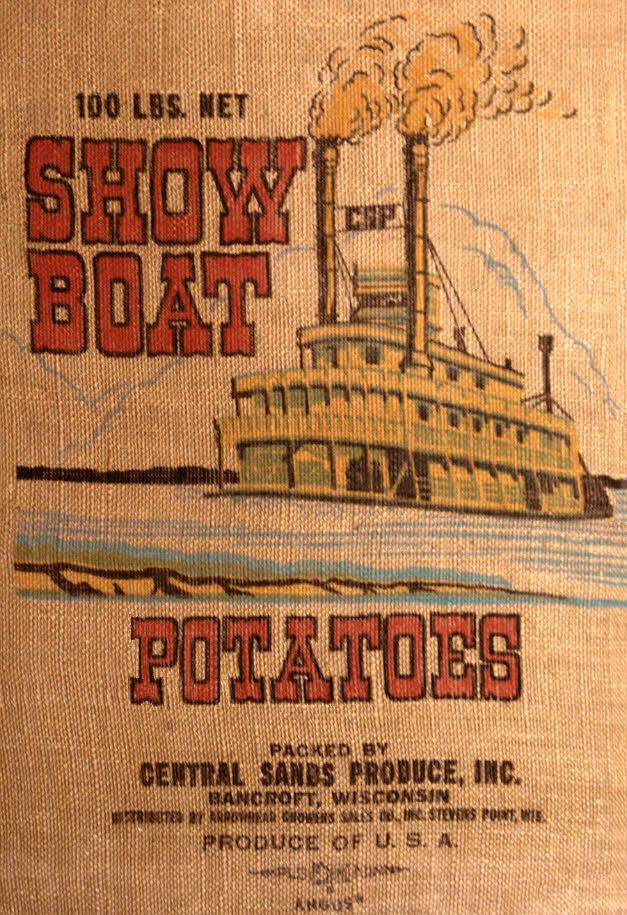
SHOW BOAT POTATOES
100 LBS. NET Burlap bag
Central Sands Produce, Incorporated
(The initials C.S.P are inside the spandrels between the smokestacks of the steamboat)
Bancroft, Wisconsin
Distributed by Arrowhead Growers Sales Co. Inc.
Stevens Point, Wisconsin
Produce of U.S.A.
ANGUS, the name on the bottom line may have been the name of the company who manufactured the bag

Cotton Blossom BAR-B-QUE restaurant at Worlds of Fun park
At Worlds of Fun amusement park near Kansas City, MO the restored MGM prop boat COTTON BLOSSOM from the 1951 SHOW BOAT was long ago dismantled but as a sort of tribute to its memory a new theme restaurant is opening at the park this year with the name COTTON BLOSSOM BAR-B-QUE. Below excerpt from coaster101.com article on the eatery. New logo attached.
coaster101.com
Worlds Of Fun's New Restaurant Re-Themed to Cotton Blossom BBQ
BY ANDREW · JANUARY 11, 2019
Back in August, we reported that a new flagship restaurant, Boathouse Grill, was headed to Worlds of Fun in 2019. The restaurant is still coming, but for those looking for that nautical name on the midways of Worlds of Fun next year, you might get lost. The park has decided to re-name the new restaurant to Cotton Blossom BBQ, which according to Worlds of Fun, is "a name that better suits the park's identity and the building's location."

With the exception of images credited to public institutions,
everything on this page is from a private collection.
Please contact Steamboats.com for permission for commercial use.*
All captions provided by Dave Thomson, Steamboats.com primary contributor and historian.
